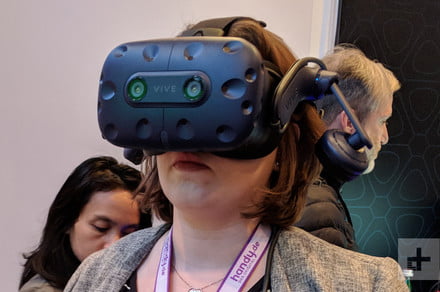The latest beta of SteamVR now includes a new feature that fine-tunes virtual reality experiences to match your PC’s graphics chip for the best experience possible. This component will alleviate the need to upgrade the PC’s graphics card when customers purchase next-generation headsets with higher resolutions than the Oculus Rift and HTC Vive.
According to Valve Software’s Alex Vlachos, SteamVR now measures the speed of the installed graphics chip and tells applications to render the experience at a certain resolution. On a more technical level, it determines how many “VR megapixels per second” the GPU can safely handle at 90 frames per second, and sets the resolution accordingly.
For example, if the chip can’t handle the application at its native resolution, viewers will see everything at a lower resolution that is more appropriate for their GPU’s rendering capabilities. Likewise, if the chip can handle the experience at a higher resolution than the application’s native setting, the experience will see a visual boost due to a higher resolution.
“The best part is that customers won’t have to do anything to get the correct resolution settings. The SteamVR runtime does all the hard work. Of course, if one prefers a different resolution, it’s easy to manually override this by editing the Video settings in SteamVR (previously known as supersample settings),” Vlachos said.
Vlachos believes the new SteamVR component should reduce the cost of VR on a whole. If customers already own a “VR Ready PC” or “VR Ready GPU,” there won’t be any need to upgrade. Vlachos says many applications still don’t take full advantage of the GPUs currently on the market.
Valve’s approach with this new SteamVR component is that for decades, PC gamers have upgraded their monitors without changing the core components in their PC. The company is now applying the same logic to VR headsets given they’re just receivers and don’t really do any hard work. Of course, to get the maximum resolution supported by the HTC Vive Pro, you need a graphics card that can handle the resolution at 90 frames per second. If it can’t, a GPU upgrade may be in order anyway.
Outside of the benefits for VR headset owners, the new SteamVR component is good for developers, too. That’s because they are required to test applications on every headset running on every supported graphics chip available on the market. They must make “difficult trade-offs” in order to render high-resolution graphics on next-generation headsets.
More importantly, with more than 2,000 VR applications made available through Steam, getting developers to update those applications to support newer headsets and higher resolutions is out of the question. But that is no longer the case given the new SteamVR feature pulls VR headsets out of the development process.
The new feature is only available through the SteamVR Beta. You can join the fun by going to “Library > Tools” and right-clicking on “SteamVR” to pull up the “Properties” box. Click the “Beta” tab and select “beta” from the drop-down menu.
Editors’ Recommendations
- HTC Vive vs. Vive Pro
- Oculus Rift vs. Vive Pro
- HTC Vive review
- HTC’s Vive Focus mobile VR headset uses the same lenses, displays as Vive Pro
- Twitter tease indicates HTC could reveal a 4K Vive VR headset at CES

